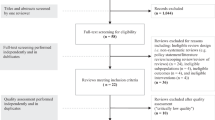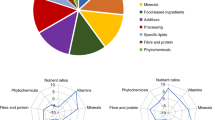Abstract
Background
In an effort to combat childhood obesity the WHO has called on governments to restrict the marketing of unhealthy foods to children. Regulators have turned to nutrient profiling (NP) to provide the evidence for their decisions. This has resulted in the development of NP models, of which the validity of only a few have been established. The aim of this study was to assess the construct validity of various NP models for the purpose of restricting the marketing of unhealthy foods to children in South Africa by comparing the classification of foods by the models to the ranking of the same foods by registered dietitians.
Methods
Six current NP models were identified, then a representative food database of 120 foods was developed and each individual food was classified by each of the six models. Lastly dietitians were recruited to rank the healthfulness of the same 120 foods.
Results
Dietitians allowed 24% of the included foods for marketing to children, whereas the percentage of foods allowed by the included models ranged from 7 to 47%. Majority of pairwise comparisons between the NP models and dietitians yielded ҡ statistics >0.6, indicating substantial agreement. An almost perfect pairwise agreement was found between dietitians and the WHO Regional Office for Europe model.
Conclusion
The included NP models displayed good construct validity by agreeing with dietitians on what are ‘less healthy’ foods, thus the foods not allowed for marketing. The findings of this study contributes to the process of establishing validity of NP models.
This is a preview of subscription content, access via your institution
Access options
Subscribe to this journal
Receive 12 print issues and online access
$259.00 per year
only $21.58 per issue
Buy this article
- Purchase on Springer Link
- Instant access to full article PDF
Prices may be subject to local taxes which are calculated during checkout

Similar content being viewed by others
References
Sadeghirad B, Duhaney T, Motaghipisheh S, Campbell N, Johnston B. Influence of unhealthy food and beverage marketing on children’s dietary intake and preference: a systematic review and meta‐analysis of randomized trials. Obes Rev. 2016;17:945–59.
Boyland EJ, Nolan S, Kelly B, Tudur-Smith C, Jones A, Halford JC, et al. Advertising as a cue to consume: a systematic review and meta-analysis of the effects of acute exposure to unhealthy food and nonalcoholic beverage advertising on intake in children and adults. Am J Clin Nutr. 2016;103:519–33.
WHO. Set of recommendations on the marketing of foods and non-alcoholic beverages to children. 2010. https://www.who.int/dietphysicalactivity/marketing-food-to-children/en/. Accessed Oct 2019.
Rayner M. Nutrient profiling for regulatory purposes. Proc Nutr Soc. 2017;76:230–6.
Labonte M-E, Poon T, Gladanac B, Ahmed M, Franco-Arellano B, Rayner M, et al. Nutrient profile models with applications in government-led nutrition policies aimed at health promotion and noncommunicable disease prevention: a systematic review. Adv Nutr. 2018;9:741–88.
WHO. Nutrient profiling. 2017. https://www.who.int/nutrition/topics/profiling/en/. Accessed Jul 2019.
Rayner M, Scarborough P, Kaur A. Nutrient profiling and the regulation of marketing to children. Possibilities and pitfalls. Appetite 2013;62:232–5.
WHO. Nutrient profiling: report of a WHO/IASOtechnical meeting. Geneva: World Health Organization; 2010. https://www.who.int/nutrition/publications/profiling/WHO_IASO_report2010.pdf?ua=1. Accessed Jul 2019.
Cooper SL, Pelly FE, Lowe JB. Construct and criterion-related validation of nutrient profiling models: a systematic review of the literature. Appetite. 2016;100:26–40.
Townsend MS. Where is the science? What will it take to show that nutrient profiling systems work? Am J Clin Nutr. 2010;91:1109S–15S.
Drewnowski A, Fulgoni V. Nutrient profiling of foods: creating a nutrient‐rich food index. Nutr Rev. 2008;66:23–39.
Arambepola C, Scarborough P, Rayner M. Validating a nutrient profile model. Public Health Nutr. 2008;11:371–8.
Rayner M, Mizdrak A, Logstrup S, Kestens M. Reducing children’s exposure to marketing of foods and drinks that are hihg in fat, salt or sugar: what would be the best nutriet profile model? European Heart Network. 2013. https://www.researchgate.net/profile/Mike_Rayner2/publication/267198176. Accessed Jun 2019.
Poon T, Labonté M-È, Mulligan C, Ahmed M, Dickinson KM, L’Abbé MR. Comparison of nutrient profiling models for assessing the nutritional quality of foods: a validation study. Br J Nutr. 2018;120:567–82.
Wicks M, Wright H, Wentzel-Viljoen E. Restricting the marketing of foods and drinks to children in South Africa: Are all nutrient profiling models the same? Br J Nutr. 2017;116:2150–9.
Rayner M, Scarborough P, Stockley L. Nutrient profiles: options for definitions for use in relation to food promotion and children’s diets. London: Food Standards Agency. 2004. https://www.researchgate.net/profile/Mike_Rayner2/publication/267198176_Nutrient_profiles_Options_for_definitions_for_use_in_relation_to_food_promotion_and_children’s_diets_Final_report/links/5493ffa70cf240d1cb4d2236/Nutrient-profiles-Options-for-definitions-for-use-in-relation-to-food-promotion-and-childrens-diets-Final-report.pdf. Accessed Jul 2019.
Scarborough P, Boxer A, Rayner M, Stockley L. Testing nutrient profile models using data from a survey of nutrition professionals. Public Health Nutr. 2007;10:337–45.
South African Department of Health. R. 429 Foodstuffs, Cosmetics and Disinfectants Act (54/1972): regulations relating to the labelling and advertising of foods: amendment. 2014. http://www.gpwonline.co.za/Gazettes/Gazettes/37695_29-5_Health.pdf. Accessed Jul 2019.
Wicks M. The validation of a suitable nutrient profiling model for South Africa: North-West University. 2012. https://repository.nwu.ac.za/handle/10394/9253. Accessed Jul 2019.
Lee SJ. Using existing dietary data for evaluating the construct validity of a nutrient profiling model. North-West University. 2013. http://dspace.nwu.ac.za.nwulib.nwu.ac.za/handle/10394/11743. Accessed Jun 2019.
Wentzel-Viljoen E, Jerling J, Vorster E, Wicks M, Lee S. Report: testing and software development of a nutrient profiling model for South Africa. Report to the South African National Department of Health, Directorate: Food Control, contract no. NDOH 17/2011–2012. Potchefstroom: North-West University; 2012.
Ni Mhurchu C, Mackenzie T, Vandevijvere S. Protecting New Zealand children from exposure to the marketing of unhealthy foods and drinks: a comparison of three nutrient profiling systems to classify foods. N Z Med J. 2016;129:45–53.
Elliott C, Scime NV. Nutrient profiling and child-targeted supermarket foods: assessing a “Made in Canada” Policy approach. Int J Environ Res Public Health. 2019;16:639.
Vandevijvere S, Barquera S, Caceres G, Corvalan C, Karupaiah T, Kroker‐Lobos MF, et al. An 11‐country study to benchmark the implementation of recommended nutrition policies by national governments using the Healthy Food Environment Policy Index, 2015–2018. Obes Rev. 2019;20:57–66.
UK Food Standards Agency. Nutrient profiling technical guidance. https://www.food.gov.uk/sites/default/files/multimedia/pdfs/techguidenutprofiling.pdf. Accessed Aug 2019.
WHO Regional Office for Europe nutrient profile model. Nutrient profile model. 2015 http://www.euro.who.int/_data/assets/pdf_file/0005/270716/Nutrient-Profile-Model_Version-for-Web.pdf?ua=1. Accessed Aug 2019.
WHO. Nutrient profile model for the marketing of food and non-alcoholic beverages to children in the WHO Eastern Mediterranean Region. WHO; 2017. https://apps.who.int/iris/handle/10665/255260. Accessed June 2019.
WHO PAHO. Pan American Health Organization Nutrient Profile Model. WHO PAHO; 2016. http://iris.paho.org/xmlui/handle/123456789/18621. Accessed June 2019.
Scarborough P, Payne C, Agu C, Kaur A, Mizdrak A, Rayner M, et al. How important is the choice of the nutrient profile model used to regulate broadcast advertising of foods to children? A comparison using a targeted data set. Eur J Clin Nutr. 2013;67:815–20.
Delport J. Branding and cartoon character usage in food marketing to children: the South African picture [Unpublished thesis]. North-West University; 2015.
Wolmarans P, Danster, N, Dalton, A, Rossouw, K, Schönfeldt, H. Condensed food composition tables for South Africa. 1st ed. Parrow Valley, Cape Town: Medical Research Council; 2010.
Scarborough P, Rayner M, Stockley L, Black A. Nutrition professionals’ perception of the ‘healthiness’ of individual foods. Public Health Nutr. 2007;10:346–53.
Viera AJ, Garrett JM. Understanding interobserver agreement: the kappa statistic. Fam Med. 2005;37:360–3.
Cooper SL, Pelly F, Lowe J. Assessment of the construct validity of the Australian Health Star Rating: a nutrient profiling diagnostic accuracy study. Eur J Clin Nutr. 2017;71:1353.
South African Department of Health, Statistics South Africa, South African Medical Research Council. South African Demographic and Health Survey 2016: key indicators. 2017. https://www.statssa.gov.za/publications/Report%2003-00-09?Report%2003-00-092016.pdf. Accessed Oct 2019.
Statistics South Africa. Poverty trends in South Africa. 2017. https://www.statssa.gov.za/publications/Report-03-10-06/Report-03-10-062015.pdf. Accessed Nov 2019.
South African Department of Health. Guidelines on nutrition for Early Childhood Development Centres. Pretoria: South African National Department of Health; 2016. www.doh.gov.za. Accessed Oct 2019.
WHO. Healthy diet fact sheet World Health Organization. 2018. https://www.who.int/news-room/fact-sheets/detail/healthy-diet. Accessed Mar 2019.
Nortje N, Faber M, De Villiers A. School tuck shops in South Africa—an ethical appraisal. South Afr J Clin Nutr. 2017;30:3.
Manyanga T, Tremblay MS, Chaput J-P, Katzmarzyk PT, Fogelholm M, Hu G, et al. Socioeconomic status and dietary patterns in children from around the world: different associations by levels of country human development? BMC Public Health. 2017;17:457.
Maher A, Wilson N, Signal L. Advertising and availability of’obesogenic’foods around New Zealand secondary schools: a pilot study. N. Z Med J. 2005;118:1218.
da Costa Louzada ML, Baraldi LG, Steele EM, Martins APB, Canella DS, Moubarac J-C, et al. Consumption of ultra-processed foods and obesity in Brazilian adolescents and adults. Prev Med 2015;81:9–15.
Moubarac J-C, Batal M, Louzada M, Steele EM, Monteiro C. Consumption of ultra-processed foods predicts diet quality in Canada. Appetite 2017;108:512–20.
Vlassopoulos A, Masset G, Charles VR, Hoover C, Chesneau-Guillemont C, Leroy F, et al. A nutrient profiling system for the (re) formulation of a global food and beverage portfolio. Eur J Nutr. 2017;56:1105–22.
Double-duty actions [press release]. Geneva: World Health Organization; 2017.
Hanks AS, Just DR, Brumberg A. Marketing vegetables in elementary school cafeterias to increase uptake. Pediatrics 2016;138:e20151720.
Keller KL, Kuilema LG, Lee N, Yoon J, Mascaro B, Combes A-L, et al. The impact of food branding on children’s eating behavior and obesity. Physiol Behav 2012;106:379–86.
Smits T, Vandebosch H. Endorsing children’s appetite for healthy foods: Celebrity versus non-celebrity spokes-characters. J Commun. 2012;37:371–91.
Acknowledgements
We thank Willie Smit and Marius Smuts for developing the nutrient criteria algorithms. We also thank Annette Van der Merwe for programming the online survey.
Author information
Authors and Affiliations
Contributions
MW developed the concept, captured and analysed the data, conducted the statistical analysis and wrote the paper. EWV and HW developed the concept and critically revised the paper. All authors read and approved the final paper.
Corresponding author
Ethics declarations
Conflict of interest
The authors declare that they have no conflict of interest.
Additional information
Publisher’s note Springer Nature remains neutral with regard to jurisdictional claims in published maps and institutional affiliations.
Rights and permissions
About this article
Cite this article
Wicks, M., Wright, H. & Wentzel-Viljoen, E. Assessing the construct validity of nutrient profiling models for restricting the marketing of foods to children in South Africa. Eur J Clin Nutr 74, 1065–1072 (2020). https://doi.org/10.1038/s41430-020-0566-y
Received:
Revised:
Accepted:
Published:
Issue Date:
DOI: https://doi.org/10.1038/s41430-020-0566-y



